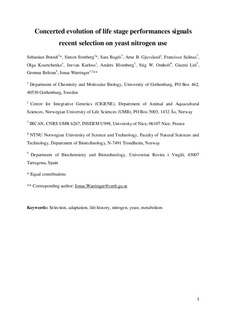Concerted Evolution of Life Stage Performances Signals Recent Selection on Yeast Nitrogen Use
| dc.contributor.author | Ibstedt, Sebastian | |
| dc.contributor.author | Stenberg, Simon | |
| dc.contributor.author | Bages, Sara | |
| dc.contributor.author | Gjuvsland, Arne Bjørke | |
| dc.contributor.author | Salinas, Francisco | |
| dc.contributor.author | Kourtchenko, Olga | |
| dc.contributor.author | Samy, Jeevan K.A. | |
| dc.contributor.author | Blomberg, Anders | |
| dc.contributor.author | Omholt, Stig William | |
| dc.contributor.author | Liti, Gianni | |
| dc.contributor.author | Beltran, Gemma | |
| dc.contributor.author | Warringer, Jonas | |
| dc.date.accessioned | 2017-10-24T07:52:42Z | |
| dc.date.available | 2017-10-24T07:52:42Z | |
| dc.date.created | 2015-01-22T13:54:50Z | |
| dc.date.issued | 2015 | |
| dc.identifier.citation | Molecular biology and evolution. 2015, 32 (1), 153-161. | nb_NO |
| dc.identifier.issn | 0737-4038 | |
| dc.identifier.uri | http://hdl.handle.net/11250/2461600 | |
| dc.description.abstract | Exposing natural selection driving phenotypic and genotypic adaptive differentiation is an extraordinary challenge. Given that an organism’s life stages are exposed to the same environmental variations, we reasoned that fitness components, such as the lag, rate, and efficiency of growth, directly reflecting performance in these life stages, should often be selected in concert. We therefore conjectured that correlations between fitness components over natural isolates, in a particular environmental context, would constitute a robust signal of recent selection. Critically, this test for selection requires fitness components to be determined by different genetic loci. To explore our conjecture, we exhaustively evaluated the lag, rate, and efficiency of asexual population growth of natural isolates of the model yeast Saccharomyces cerevisiae in a large variety of nitrogen-limited environments. Overall, fitness components were well correlated under nitrogen restriction. Yeast isolates were further crossed in all pairwise combinations and coinheritance of each fitness component and genetic markers were traced. Trait variations tended to map to quantitative trait loci (QTL) that were private to a single fitness component. We further traced QTLs down to single-nucleotide resolution and uncovered loss-of-function mutations in RIM15, PUT4, DAL1, and DAL4 as the genetic basis for nitrogen source use variations. Effects of SNPs were unique for a single fitness component, strongly arguing against pleiotropy between lag, rate, and efficiency of reproduction under nitrogen restriction. The strong correlations between life stage performances that cannot be explained by pleiotropy compellingly support adaptive differentiation of yeast nitrogen source use and suggest a generic approach for detecting selection. | nb_NO |
| dc.language.iso | eng | nb_NO |
| dc.publisher | Oxford University Press | nb_NO |
| dc.title | Concerted Evolution of Life Stage Performances Signals Recent Selection on Yeast Nitrogen Use | nb_NO |
| dc.type | Journal article | nb_NO |
| dc.type | Peer reviewed | nb_NO |
| dc.description.version | acceptedVersion | nb_NO |
| dc.source.pagenumber | 153-161 | nb_NO |
| dc.source.volume | 32 | nb_NO |
| dc.source.journal | Molecular biology and evolution | nb_NO |
| dc.source.issue | 1 | nb_NO |
| dc.identifier.doi | 10.1093/molbev/msu285 | |
| dc.identifier.cristin | 1204903 | |
| dc.relation.project | Notur/NorStore: NN4653K | nb_NO |
| dc.relation.project | Norges forskningsråd: 222364 | nb_NO |
| dc.description.localcode | This is a pre-copyedited, author-produced version of an article accepted for publication in Molecular Biology and Evolution following peer review. The version of record is available online at: https://academic.oup.com/mbe/article-lookup/doi/10.1093/molbev/msu285 | nb_NO |
| cristin.unitcode | 194,66,15,0 | |
| cristin.unitname | Institutt for bioteknologi og matvitenskap | |
| cristin.ispublished | true | |
| cristin.fulltext | postprint | |
| cristin.qualitycode | 2 |
